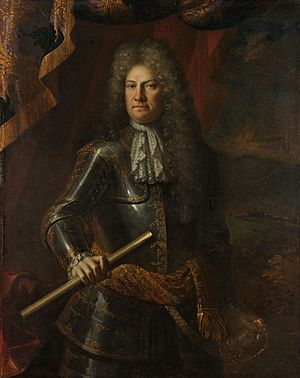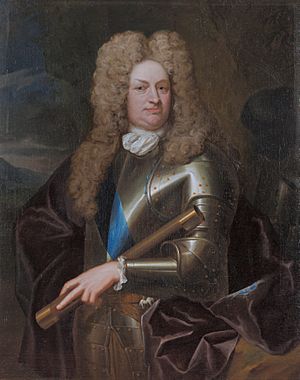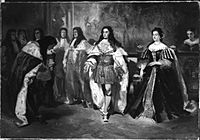Godert de Ginkel, 1st Earl of Athlone facts for kids
Quick facts for kids
Godard van Reede
|
|
|---|---|

1st Earl of Athlone
|
|
| Earl of Athlone | |
| Personal details | |
| Born | 14 June 1644 Amerongen |
| Died | 11 February 1703 (aged 58) Utrecht |
| Occupation | General |
| Military service | |
| Battles/wars |
|
Godard van Reede (born 1644, died 1703) was a famous Dutch general. He was also known as the 1st Earl of Athlone. He became very important during a big war in Ireland.
Contents
Becoming a General
Godard van Reede was born in Amerongen, a town in the Netherlands. He came from a noble family. When he was just 12 years old, he joined the Dutch army as an officer in the cavalry. Cavalry are soldiers who fight on horseback.
He served as a colonel and brigadier during the Franco-Dutch War. This was a war between France and the Netherlands. He fought in the Battle of Seneffe and was badly hurt. Later, he was promoted to major-general in 1675. By 1683, he became a lieutenant-general.
In 1688, Godard van Reede joined William, Prince of Orange. William was traveling to England in an event called the "Glorious Revolution". This event removed King James II from power.
The next year, van Reede showed his skill. He chased down and captured a Scottish army group that had rebelled for King James. This happened near Ipswich. This event helped create the first Mutiny Act, which set rules for soldiers.
In 1690, van Reede went with William III to Ireland. They went to fight against the Jacobites, who supported King James. Van Reede led Dutch cavalry at the Battle of the Boyne. After the king returned to England, General van Reede was put in charge of the war in Ireland.
Leading the Williamite Army
In the spring of 1691, van Reede took command in Ireland. He set up his main base in Mullingar. One of the important leaders under him was the Marquis of Ruvigny. He was a chief of the Huguenot refugees.
In early June, van Reede captured the fortress of Ballymore. His army took 1,000 enemy soldiers as prisoners. The Williamite army lost only eight men. After fixing up Ballymore, the army marched to Athlone. Athlone was a very important fortified town in Ireland. It was key to the Jacobite defense because it crossed the River Shannon.
The Irish defenders of Athlone were led by a skilled French general, the Marquis de St Ruth. The fighting began on June 19. On June 30, van Reede's army stormed the town. The Irish army then moved towards Galway. They set up their next defense at Aughrim.
After making Athlone stronger and leaving soldiers there, van Reede led his forces. On July 8, he went west to chase the retreating army. They met the Jacobite army in a big battle on July 12, 1691, at Aughrim.
The Battle of Aughrim
The Battle of Aughrim was a very important fight. It almost ended the war in favor of the Williamites. Van Reede decided to attack right away. The battle was tough and uncertain for a while. The Jacobite position became much weaker when their French commander, Marquis de Saint Ruth, was killed.
After his death, the Jacobite forces became disorganized and ran away. This happened in the early morning of July 13. This battle is often called one of the bloodiest battles ever in the British Isles. Historians believe that about 5,000 to 7,000 men died. Van Reede reported that 526 Jacobite prisoners were captured.
Van Reede had promised that all captured soldiers would be treated as prisoners of war. However, the main officers were sent to the Tower of London. Most of the regular soldiers were sent to Lambay Island. Many of them died there from sickness and hunger.
Next, Galway surrendered. Its soldiers were allowed to go to Limerick. In Limerick, the viceroy Tyrconnell was in charge of a large force. But he died suddenly in early August. Command then went to General Patrick Sarsfield, 1st Earl of Lucan, and a Frenchman named d'Usson.
Van Reede's army arrived at Limerick on the day Tyrconnell died. The bombardment and siege began right away. Van Reede used a clever plan to cross the River Shannon. He captured the camp of the Irish cavalry. A few days later, he stormed the fort on Thomond Bridge.
After difficult talks, a surrender agreement was signed. This was the Treaty of Limerick. It had terms for both civilians and soldiers. This treaty completed the Williamite victory in Ireland.
Van Reede's great service was recognized and rewarded. The House of Commons formally thanked him. The king made him the 1st Earl of Athlone and Baron of Aughrim. He was also given a lot of land that had belonged to the Earl of Limerick. However, the English Parliament later took back this land.
Later Life and Family
The Earl of Athlone continued to serve in the English Army. He went with the king to Europe in 1693. He fought in the sieges of Namur in 1695 and the Battle of Neerwinden. He also helped destroy a French military supply area at Givet.
In the War of the Spanish Succession, Lord Athlone became the first Field Marshal of the Dutch States Army in 1702. He served under the 1st Duke of Marlborough, who was the main commander of the Allied forces in the Low Countries.
Godard van Reede married Ursula Philipota van Raesvelt. She was the heiress of Castle Middachten near Arnhem. They had several children together.
When he died in 1703, his oldest son, Frederick Christiaan van Reede, became the 2nd Earl. Frederick (1668–1719) was also a skilled soldier. He served under William III and Queen Anne. He became an English citizen in 1696.
The title of Earl of Athlone ended in 1844. This happened when the 9th Earl died without children. However, the title was created again two more times, in 1890 and 1917.
See also
- List of people on stamps of Ireland
- Williamite War in Ireland



